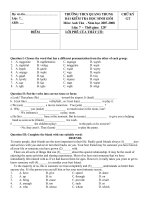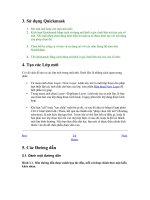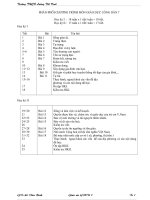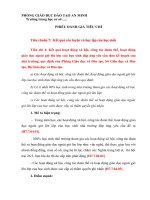7.4. SCALE-FREE NETWORKS181systematically disabling hubs should quickly partition a network into several disjoint components, a highly undesirable situation. To illustrate these matters, Figure 7.12 shows what happens when we systematically remove ver pdf
Bạn đang xem bản rút gọn của tài liệu. Xem và tải ngay bản đầy đủ của tài liệu tại đây (250.86 KB, 1 trang )
7.4. SCALE-FREE NETWORKS 181
systematically disabling hubs should quickly partition a network into sev-
eral disjoint components, a highly undesirable situation.
To illustrate these matters, Figure 7.12 shows what happens when we
systematically remove vertices from a scale-free graph in comparison to re-
moving the best-connected vertices from an ER random graph. We also
show the effect of removing randomly selected vertices from a scale-free
graph (which is very similar to randomly removing vertices from an ER
graph). A scale-free network is thus seen to be sensitive to a targeted attack,
but just as robust as an ER random graph in the case of a random attack.
1.0
0.8
0.6
0.4
0.2
0.2 0.4 0.6 0.8 1.0
Scale-free
network
Random
network
Scale-free
network,
randomremoval
Fractionofremovedvertices
Fractionoutsidegiantcluster
Figure 7.12: The fraction of vertices outside the giant component when removing
hubs from a scale-free graph, and those from an ER random graph.
Related networks
As we mentioned, the Barab
´
asi-Albert approach for constructing a scale-
free graph has one important shortcoming when comparing it to real-world
networks: its relatively low clustering coefficient. A better understanding
of real-world phenomena should normally be reflected by better models
and in this sense, a BA random graph is difficult to validate against many
real-world data. Therefore, researchers have been seeking solutions for con-
structing scale-free graphs that have a high clustering coefficient.
As argued by Dorogovtsev et al. [2003], constructing such graphs is ac-
tually quite simple. The trick is to make sure that there are many triangles.
This can be achieved, for example, by adding an edge to a triple at each step
of the growing process. (Recall that a triple was a subgraph with 3 vertices
and 2 edges.) Holme and Kim [2002] provide a scheme that combines scale-
freeness and at the same time allows to tune to what extent clustering is to
be provided. Their algorithm proceeds as follows:









